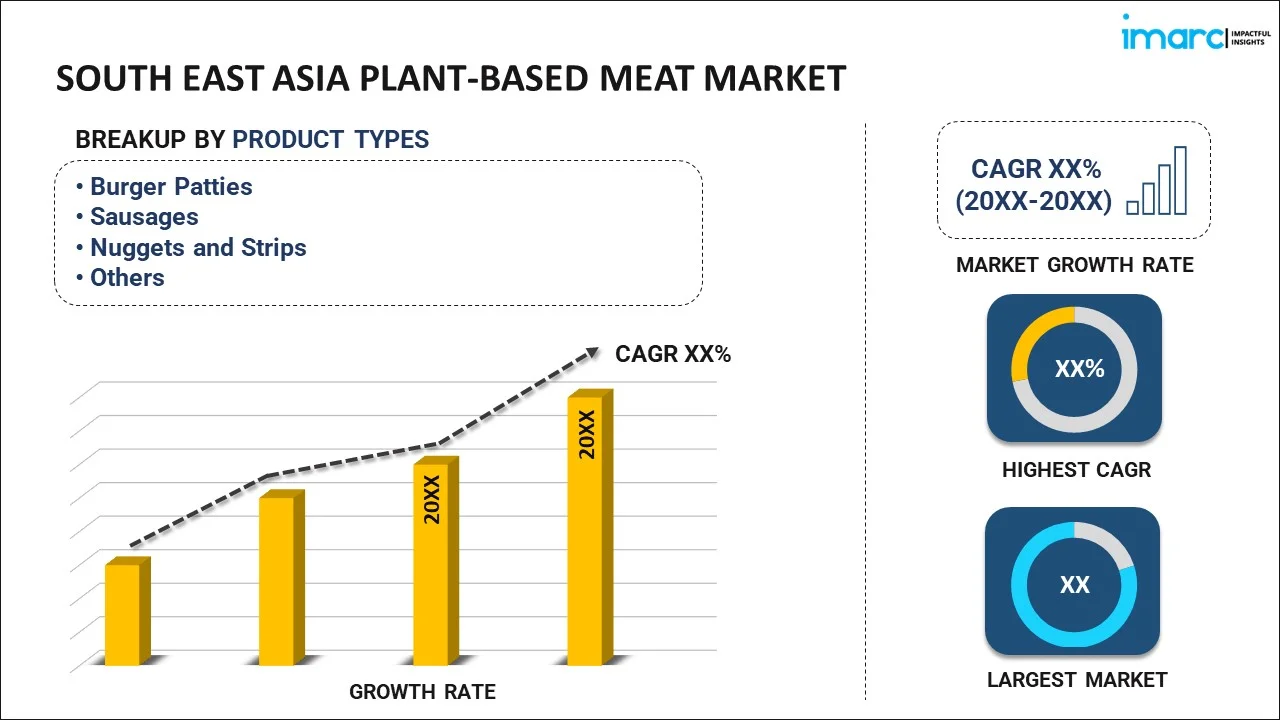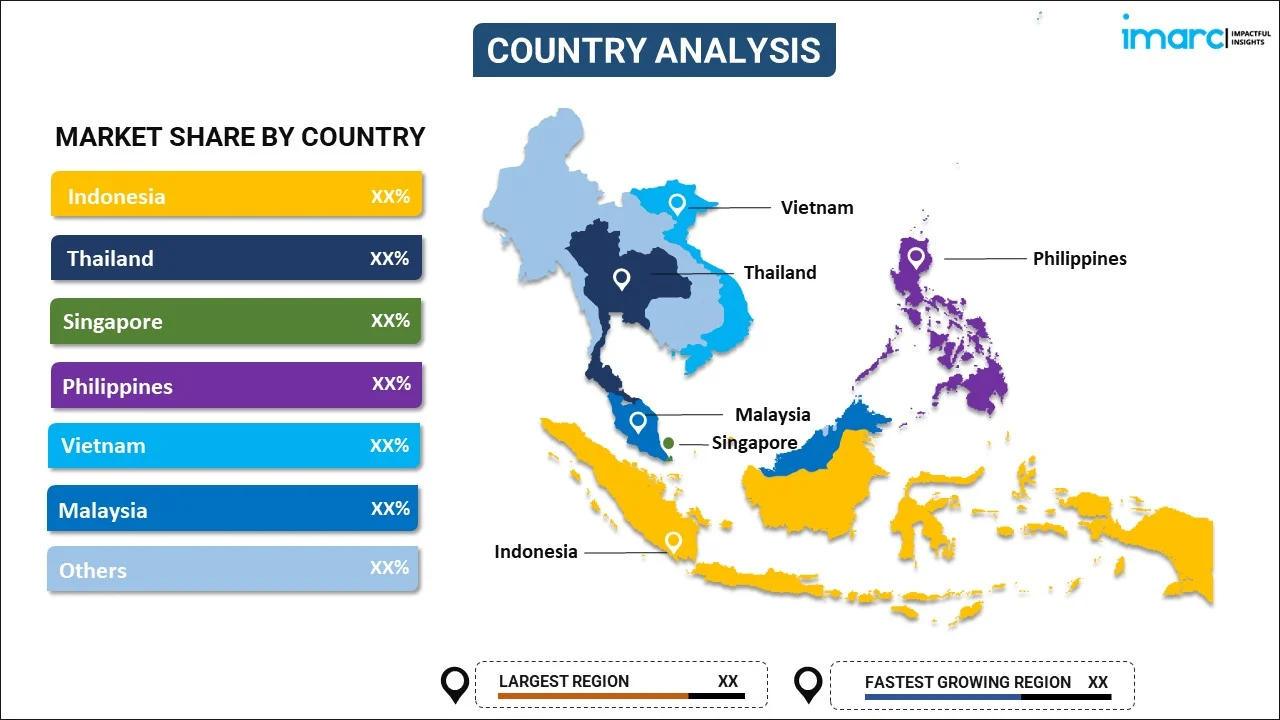
South East Asia Plant-Based Meat Market Report by Product Type (Burger Patties, Sausages, Nuggets and Strips, Ground Meat, Meatballs, and Others), Source (Soy, Wheat, Peas, and Others), Meat Type (Chicken, Beef, Pork, and Others), Distribution Channel (Restaurants and Catering Industry, Supermarkets and Hypermarkets, Convenience and Specialty Stores, Online Retail), and Country 2025-2033
Market Overview:
South East Asia plant-based meat market size is projected to exhibit a growth rate (CAGR) of 23.94% during 2025-2033. The rising consumer awareness towards environmental, sustainability, ethical, and animal welfare considerations is primarily driving the market growth.
|
Report Attribute
|
Key Statistics
|
|---|---|
|
Base Year
|
2024 |
|
Forecast Years
|
2025-2033
|
|
Historical Years
|
2019-2024
|
| Market Growth Rate (2025-2033) | 23.94% |
Plant-based meat, which is also referred to as vegan or vegetarian meat, is a food alternative engineered to imitate the taste, texture, and appearance of conventional animal-based meats like beef, chicken, and pork. This type of food is created using plant-derived ingredients, including soy, peas, mushrooms, and grains, that are combined to simulate the sensory experience of consuming animal meat. Recently, the popularity of plant-based meats has surged due to their perceived health advantages and positive impact on the environment. These products often promote lower levels of saturated fats and cholesterol in comparison to traditional animal-based meat products. Moreover, they contribute to a reduced environmental footprint by consuming less water and land and producing fewer greenhouse gases during the manufacturing process.
South East Asia Plant-Based Meat Market Trends:
The South East Asia plant-based meat market is experiencing a notable upsurge as a result of a heightened awareness of the potential health benefits associated with plant-based diets. Furthermore, mounting concerns about environmental degradation and the pressing issue of climate change have fueled the exploration of more sustainable food options within the region. Moreover, the ethical treatment of animals has become a key driver in the shift towards plant-based diets in the South East Asia. With a heightened focus on animal welfare, many consumers are making the conscious choice to opt for plant-based meats, thereby avoiding contributing to the practices within the livestock industry that raise ethical concerns. The South East Asian market has witnessed the development of a diverse range of plant-based meat products, including burgers, sausages, meatballs, and nuggets, expanding culinary options for consumers and catering to a variety of preferences. Additionally, the growing availability of plant-based meat products in mainstream grocery stores, restaurants, and fast-food chains has improved accessibility, enabling a broader audience to incorporate these alternatives into their dietary choices. Notably, strategic partnerships between plant-based meat producers and foodservice establishments are expected to play a vital role in propelling the expansion of the market across the South East Asian region over the forecasted period.
South East Asia Plant-Based Meat Market Segmentation:
IMARC Group provides an analysis of the key trends in each segment of the market, along with forecasts at the regional and country levels for 2025-2033. Our report has categorized the market based on product type, source, meat type, and distribution channel.
Product Type Insights:

- Burger Patties
- Sausages
- Nuggets and Strips
- Ground Meat
- Meatballs
- Others
The report has provided a detailed breakup and analysis of the market based on the product type. This includes burger patties, sausages, nuggets and strips, ground meat, meatballs, and others.
Source Insights:
- Soy
- Wheat
- Peas
- Others
A detailed breakup and analysis of the market based on the source have also been provided in the report. This includes soy, wheat, peas, and others.
Meat Type Insights:
- Chicken
- Beef
- Pork
- Others
The report has provided a detailed breakup and analysis of the market based on the meat type. This includes chicken, beef, pork, and others.
Distribution Channel Insights:
- Restaurants and Catering Industry
- Supermarkets and Hypermarkets
- Convenience and Specialty Stores
- Online Retail
A detailed breakup and analysis of the market based on the distribution channel have also been provided in the report. This includes restaurants and catering industry, supermarkets and hypermarkets, convenience and specialty stores, and online retail.
Country Insights:

- Indonesia
- Thailand
- Singapore
- Philippines
- Vietnam
- Malaysia
- Others
The report has also provided a comprehensive analysis of all the major regional markets, which include Indonesia, Thailand, Singapore, Philippines, Vietnam, Malaysia, and others.
Competitive Landscape:
The market research report has also provided a comprehensive analysis of the competitive landscape. Competitive analysis such as market structure, key player positioning, top winning strategies, competitive dashboard, and company evaluation quadrant has been covered in the report. Also, detailed profiles of all major companies have been provided. Some of the key players include:
- Green Rebel Foods
- Let's Plant Meat
- Absolute Plant
(Please note that this is only a partial list of the key players, and the complete list is provided in the report.)
South East Asia Plant-Based Meat Market Report Coverage:
| Report Features | Details |
|---|---|
| Base Year of the Analysis | 2024 |
| Historical Period | 2019-2024 |
| Forecast Period | 2025-2033 |
| Units | Billion USD |
| Scope of the Report | Exploration of Historical and Forecast Trends, Industry Catalysts and Challenges, Segment-Wise Historical and Predictive Market Assessment:
|
| Product Types Covered | Burger Patties, Sausages, Nuggets and Strips, Ground Meat, Meatballs, Others |
| Sources Covered | Soy, Wheat, Peas, Others |
| Meat Types Covered | Chicken, Beef, Pork, Others |
| Distribution Channels Covered | Restaurants and Catering Industry, Supermarkets and Hypermarkets, Convenience and Specialty Stores, Online Retail |
| Countries Covered | Indonesia, Thailand, Singapore, Philippines, Vietnam, Malaysia, Others |
| Companies Covered | Green Rebel Foods, Let's Plant Meat, Absolute Plant, etc. |
| Customization Scope | 10% Free Customization |
| Post-Sale Analyst Support | 10-12 Weeks |
| Delivery Format | PDF and Excel through Email (We can also provide the editable version of the report in PPT/Word format on special request) |
Key Questions Answered in This Report:
- How has the South East Asia plant-based meat market performed so far and how will it perform in the coming years?
- What has been the impact of COVID-19 on the South East Asia plant-based meat market?
- What is the breakup of the South East Asia plant-based meat market on the basis of product type?
- What is the breakup of the South East Asia plant-based meat market on the basis of source?
- What is the breakup of the South East Asia plant-based meat market on the basis of meat type?
- What is the breakup of the South East Asia plant-based meat market on the basis of distribution channel?
- What are the various stages in the value chain of the South East Asia plant-based meat market?
- What are the key driving factors and challenges in the South East Asia plant-based meat?
- What is the structure of the South East Asia plant-based meat market and who are the key players?
- What is the degree of competition in the South East Asia plant-based meat market?
Key Benefits for Stakeholders:
- IMARC’s industry report offers a comprehensive quantitative analysis of various market segments, historical and current market trends, market forecasts, and dynamics of the South East Asia plant-based meat market from 2019-2033.
- The research report provides the latest information on the market drivers, challenges, and opportunities in the South East Asia plant-based meat market.
- Porter's five forces analysis assist stakeholders in assessing the impact of new entrants, competitive rivalry, supplier power, buyer power, and the threat of substitution. It helps stakeholders to analyze the level of competition within the South East Asia plant-based meat industry and its attractiveness.
- Competitive landscape allows stakeholders to understand their competitive environment and provides an insight into the current positions of key players in the market.
Need more help?
- Speak to our experienced analysts for insights on the current market scenarios.
- Include additional segments and countries to customize the report as per your requirement.
- Gain an unparalleled competitive advantage in your domain by understanding how to utilize the report and positively impacting your operations and revenue.
- For further assistance, please connect with our analysts.
 Inquire Before Buying
Inquire Before Buying
 Speak to an Analyst
Speak to an Analyst
 Request Brochure
Request Brochure
 Request Customization
Request Customization




.webp)




.webp)












